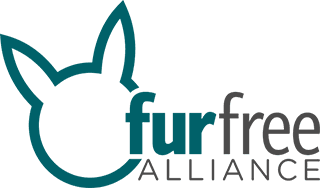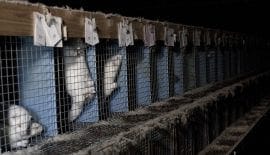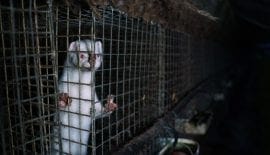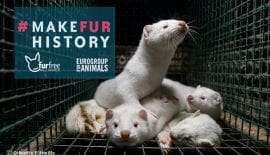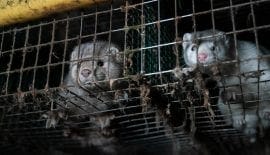Since April 2020, COVID-19 outbreaks have affected more than 450 mink fur farms in Europe and North America, resulting in the culling of over 20 million animals. The crowded, stressful and unhygienic conditions on intensive mink fur farms make them the perfect breeding ground for infectious disease. They also have the potential to create coronavirus reservoirs that could pose a risk to public health and the effectiveness for future vaccines.

Covid-19 on mink farms
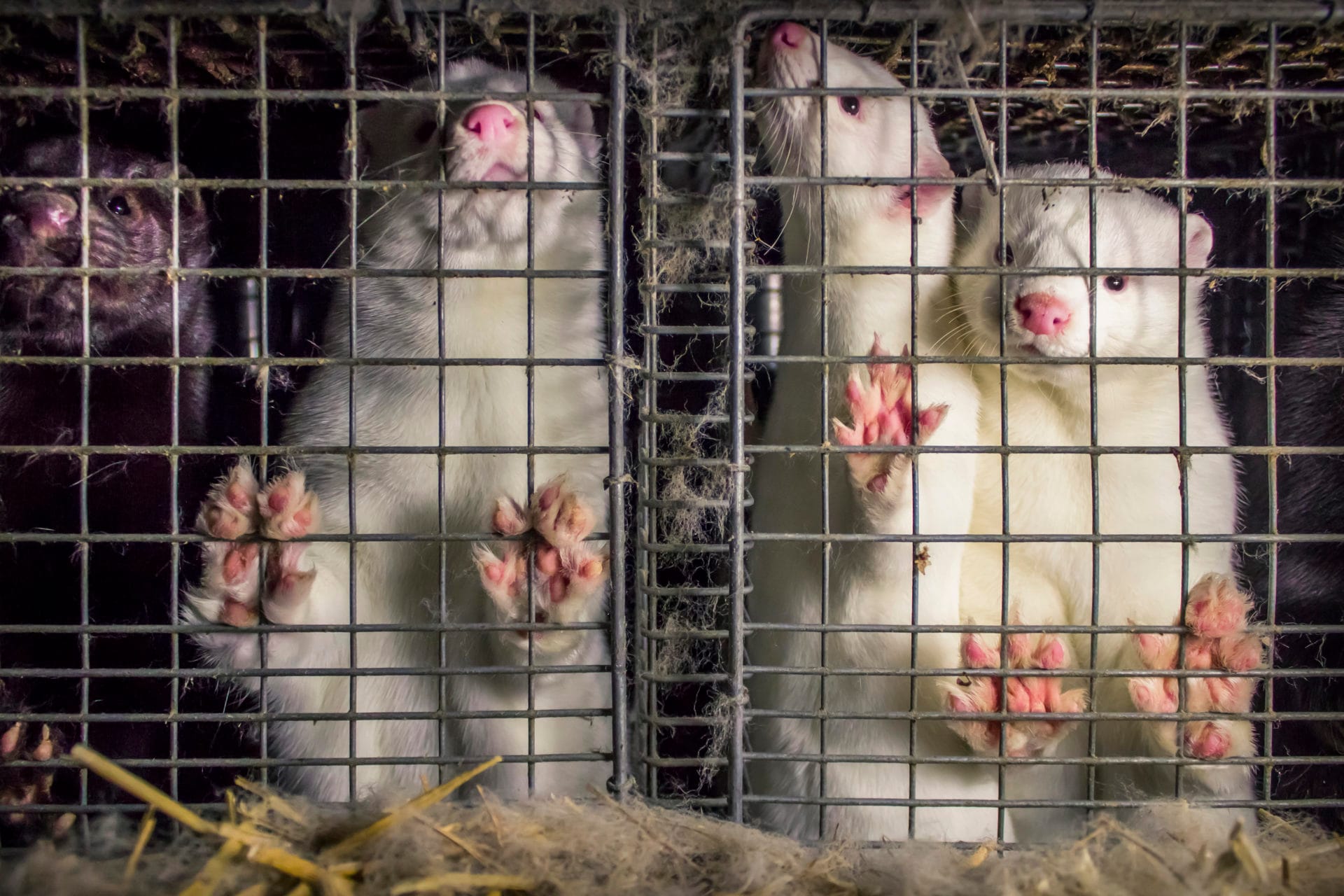
Confined to small wire cages, suffering stress and a poor quality of welfare, mink kept on fur farms are highly susceptible to COVID-19. Not only is the virus a disaster for animals, it has also been found to be transmissible back to humans. At present, over 200 human COVID-19 cases in Europe have been linked to mink farms.
In addition to mink, it is known that raccoon dogs are susceptible to coronaviruses. Moreover, red foxes have also been found to have been infected with a SARS-CoV-like virus. Like mink, both these species are farmed for fur in Europe and China; foxes are also farmed for fur in North America.
Fur farm outbreaks
Coronavirus outbreaks on mink fur farms have exposed how the inhumane and unsustainable conditions on fur farms provide the ideal conditions for a virus to spread and mutate. Poor hygiene, injuries and disease, minimal veterinary care and lack of genetic diversity are such risk factors. On top of the serious health issues inherent to intensive fur farming, mink infected with COVID-19 can suffer distress as well as respiratory and gastrointestinal symptoms.
Since the first case of COVID-19 in mink was confirmed in the Netherlands in April 2020, coronavirus outbreaks have continued to spread throughout farmed mink populations. To date, the virus has been confirmed on mink farms in 12 countries: Canada, Denmark, France, Greece, Italy, Latvia, Lithuania, Poland, Spain, Sweden, the Netherlands and the USA.
The uncontrollable spread of the coronavirus on mink fur farms demonstrates that simply culling millions of animals and then allowing farmers to return to business as usual does not preclude the further spread of SARS-CoV-2 and poses a considerable risk to human health.
Mink-to-human infection
SARS-CoV-2, the virus that causes COVID-19, can jump back and forth between humans and mink with the potential for the virus to mutate in mink prior to infecting humans. In a 2020 risk assessment, the European Centre for Disease Prevention and Control (ECDC) warned that the spread of SARS-CoV-2 in mink farms could lead to new variants that could compromise the efficacy of a vaccine: “the continued transmission of SARS-CoV-2 in mink farms may eventually give rise to other variants of concern”.
In September 2020, virus genome sequencing, testing used to trace transmission pathways, showed that 66 human cases of COVID-19 in the Netherlands were related to mink farms. Due to concerns that mink fur farms could become a viral reservoir that could cause new outbreaks in humans, the Dutch Parliament voted to bring forward the planned ban on mink breeding, which originally should have entered into force in 2024, and shut down the remaining 128 Dutch mink farms by the end of 2020.

In Denmark, 214 human cases of COVID-19 were reported as being associated with mink farms. The Danish public health authority, the State Serum Institute, raised concerns that specific mink-associated variant strain of SARS-CoV-2 identified in 12 human cases may result in a reduced response to vaccines. As a precautionary measure, the Danish government ordered the culling of all animals on the remaining fur farms, over 17 million mink, and a temporary ban on mink production in the country.
North America
COVID-19 outbreaks were declared at a mink farm in British Columbia in Canada after workers and mink tested positive for the virus in December 2020. In the United States, mink have contracted COVID-19 on 16 fur farms in the states of Utah, Wisconsin, Michigan and Oregon. In autumn 2020, investigators in Utah found an infected wild mink in the “immediate vicinity” of a farm harbouring the disease.
It is still unclear whether mink have transmitted the disease to people in North America. Unlike some countries in Europe, the U.S. and Canada have not culled all the mink at farms where the animals have contracted COVID-19 and there is a worrying lack of transparency and federal requirements concerning methods for dealing with coronavirus infections on mink farms.
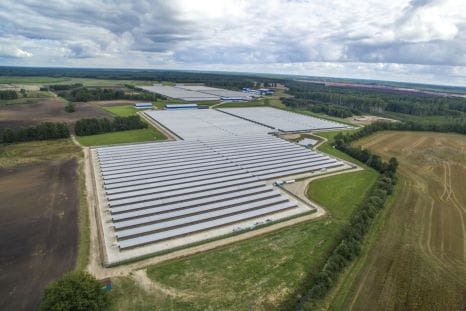
Insufficient measures
Besides countries such as Denmark (that has cancelled the mink breeding season in 2021 and 2022), Italy (that has implemented a permanent ban on fur farming in 2022), and the Netherlands (that has moved up its timeline for shutting down the industry from 2024 to 2021) most countries with affected mink fur farms have allowed producers to continue with their intensive mink breeding operations despite serious concerns about public health risks.
As we have seen in countries such Greece, Spain, Lithuania, Latvia – and in Italy where a breeding ban was in place – outbreaks have continued to occur over the winter/spring period, in between the pelting season and the breeding season, when only a small number of breeding animals were present on the farms. As the breeding season progresses, mink populations will increase approximately five fold on farms after the pups are born.
The uncontrollable spread of SARS-CoV-2 on mink fur farms in Denmark and the Netherlands, the confirmation of multiple farm infections in countries such as Sweden and the most recent outbreaks on fur farms between the pelting season and the breeding season, when only a small number of breeding animals have been present on farms (in countries such as Greece, Spain, Lithuania and Latvia) demonstrates that current measures including monitoring and biosecurity are insufficient to control virus infections and transmission.
The World Organisation for Animal Health (OIE) has called on all countries “to protect animal health and welfare, and consequently public health”:
The risk of susceptible animals, such as mink, becoming a SARS-CoV-2 reservoir generates worldwide concern, as it could pose a continued public health risk and lead to future spillover events to humans.
The risks posed by the spread of infection on fur farms requires urgent action. Unnecessary reservoirs of the SARS-CoV-2 virus must be eliminated to protect human and animal health. Urgent legislative action is required to permanently end all fur farming in the countries where it is still legally permitted.
More facts
OIE Statement on COVID-19 and mink (2020)
World Organisation for Animal Health
SARS-CoV-2 in animals used for fur farming (2021)
Risk assessment by the World Health Organisation
Risk related to spread of new SARS-CoV-2 variants of concern in the EU/EEA (2020)
Risk assessment by the European Centre for Disease Prevention and Control (ECDC)
SARS-CoV-2 spillover events (2020)
Publication in Science written by Peng Zhou and Zheng-Li Shi
SARS-CoV-2 and the human-animal interface: outbreaks on mink farms (2020)
Publication in The Lancet by M. Koopmans
International scientists call for EU emergency measures: read their statement.
Recommendations
Intensive mink farming is a breeding ground for pandemic disease risk and a disaster for animals. Twenty countries have already acted to ban the farming of animals for their fur because it is cruel, outdated and unnecessary.
In light of new evidence that fur farms can also act as reservoirs for deadly viruses, as well as create new viruses, we call on all countries to ban fur farms, and we call on G20 leaders to publicly acknowledge that fur farming must end.
Call on world leaders to stop deadly fur and sign our petition here.
